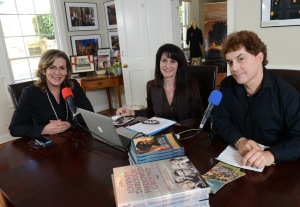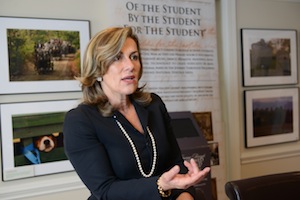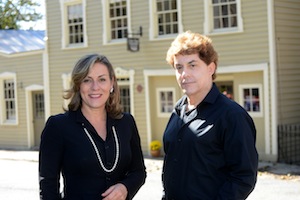Cate Magennis Wyatt Takes Us on a Journey Through Hallowed Ground
Restor ing enthusiasm in American history is the mission of the Grateful American™ Foundation.
ing enthusiasm in American history is the mission of the Grateful American™ Foundation.
So it was a pleasure for Grateful American™ Radio Show co-hosts Hope Katz Gibbs and David Bruce Smith to travel to Waterford, VA — headquarters of The Journey Through Hallowed Ground Partnership (JTHG) — and interview Cate Magennis Wyatt, the organization’s founder and president.
Wyatt’s mission is to shine a spotlight on the National Heritage Area that runs from Gettysburg, PA, through Maryland and West Virginia, to Thomas Jefferson’s Monticello in Charlottesville, VA.
Her dedication to bringing history to life is inspiring. And it’s not just teaching more people about the lives and accomplishments of the Founding Fathers and Mothers that Wyatt is interested in. Her goal is to have millions of people visit the historical swath that stretches 180 miles long and 75 miles wide, and includes:
- Nine presidential homes and birthplaces,
- More than 10,000 sites on the National Register of Historic Places, and
- Sites from the Revolutionary War, French and Indian War, War of 1812, and the Civil War.
 Indeed, this region is home not only to beautiful houses, charming towns, and battlefields — but also to 13 of the nation’s 400 national parks. So there is something for everyone to enjoy.
Indeed, this region is home not only to beautiful houses, charming towns, and battlefields — but also to 13 of the nation’s 400 national parks. So there is something for everyone to enjoy.
Scroll down for the Grateful American™ Radio Show’s Q&A with Cate Magennis Wyatt, who tells us more about The Journey Through Hallowed Ground Partnership — a fascinating program for kids and adults, which truly brings history to life.
Hope Katz Gibbs: Journey Through Hallowed Ground, a nonprofit organization and four-state partnership based in Waterford, VA, has been dedicated to raising awareness of the unparalleled American history of the region since 2005. Tell us about this project.
 Cate Magennis Wyatt: There is no place like this stretch of ground, from Gettysburg to Monticello, anywhere else in the country or the world. So when my husband and I returned to this region from London and Moscow to raise our children, I was shocked to find that there was a casino being planned in Gettysburg, and townhouses being planned overlooking Thomas Jefferson’s home on Montalto, which is part of his original estate. The site of the largest cavalry battle in the history of North America, Brandy Station, was being planned for a multimillion square-foot shopping mall. It struck me that we were taking for granted the stories of some very important individuals.
Cate Magennis Wyatt: There is no place like this stretch of ground, from Gettysburg to Monticello, anywhere else in the country or the world. So when my husband and I returned to this region from London and Moscow to raise our children, I was shocked to find that there was a casino being planned in Gettysburg, and townhouses being planned overlooking Thomas Jefferson’s home on Montalto, which is part of his original estate. The site of the largest cavalry battle in the history of North America, Brandy Station, was being planned for a multimillion square-foot shopping mall. It struck me that we were taking for granted the stories of some very important individuals.
It seemed obvious to me that if we could engage the mainstream community in every town and historic home from Gettysburg to Monticello, then we would have a fighting chance to do the right thing and honor the history made here.
At the same time, we envisioned that JTHG would also support the quality of life of all the citizens who lived here. Tourism is the number one industry of this area, yet in 2005, visitation to every site was going downward. I am pleased to report that since then, we have met or exceeded each of our objectives.

Hope Katz Gibbs: Cate, you have an incredible background. After being the youngest vice president of both Xerox Realty and Weston Capital Corporation, you joined the public sector as part of Virginia Gov. Doug Wilder’s cabinet, as the secretary of commerce and trade. Later you were appointed co-chair of the Defense Conversion Commission. Then you became an entrepreneur, creating Remington International, with businesses in London, Moscow, and Kazakhstan. What made you make the leap to create The Journey Through Hallowed Ground Partnership in 2005?
Cate Magennis Wyatt: It wasn’t so much a leap as it was a beautiful confluence of years of working with a lot of different people, who trusted each other and shared the belief that nobody should intentionally desecrate our history. The developers weren’t the enemy and were not the problem. It was simply that no one had stood back to take a longer view of some of the sites proposed for development. Townhouses aren’t bad, but overlooking Thomas Jefferson’s Monticello is not the best place for them!
David Bruce Smith: How is this huge swath of land, 180 miles, protected?
Cate Magennis Wyatt: Our goal has been to have appropriate growth in the area, growth that doesn’t desecrate our past in the name of progress, growth that allows for a continued economic engine through heritage tourism, through recreational tourism. Our strategy has been to help people see what the future landscape could be, physically and economically; that’s really what we have been able to bring to the market.
David Bruce Smith: How did you define the border? Ohio is also the birthplace of a few presidents; why did you instead choose West Virginia and Pennsylvania?

Cate Magennis Wyatt: That is a really good question, and I will tell you that we drew the line around this region with an extraordinary amount of research and forethought.
It started with the premise that the visitor experience would have to be authentic. If the economic engine behind this is to invite people to come and visit—whether for the historic, natural, or cultural attractions—it had to be authentic. And we knew it couldn’t be everything to everybody.
Our research showed that any further north of Gettysburg or west of the ridge line along the Appalachian Trail was a different culture. The same goes for anything east of where the coastal plain begins.
Once we drew the lines, we pulled every file available to find out what happened here, and sent them back to the historic site to be validated. With that information we were able to establish and validate this region as it hung together in its history.
David Bruce Smith: In this Gettysburg-to-Monticello swath, is it fair to say you have fertilized the interest in American history?
Cate Magennis Wyatt: We didn’t really have to fertilize. When we did a public opinion poll before establishing JTHG, I was blown away by the responses. So many people were so proud of the history and the culture in their own backyard. So many groups were working so hard to raise local and national attention, whether it was for an abandoned freedman’s home or The Graffiti House down in Culpeper, VA, which was used as a Civil War hospital. Even some of our national parks were struggling to gain greater national recognition.
I didn’t have to fertilize anything. But what we were able to do by bringing everyone together was heighten the awareness. So to answer your question, there was already fertile territory and interest in bringing greater attention to these remarkable sites.
 David Bruce Smith: Do you think kids’ interest in history is on the rise?
David Bruce Smith: Do you think kids’ interest in history is on the rise?
Cate Magennis Wyatt: Sadly, I don’t. But I have had the pleasure of working with outstanding history teachers. What we have found is that students learn history best through inquiry-based analysis. In other words, do not ask students to memorize dates and facts, do not expect to engage students emotionally or personally with our shared history by having them read a textbook. Instead, in one of our programs, using only primary source documents, we put students “in the books” of people in their own community who lived years ago. No textbooks, no Google allowed.
Students assume the identity of these people. They have to face the facts of what life was like at that time. We do not tell them the end of the story, so the students have to decide what they would do under those circumstances, and then it becomes personal.

We introduce into this process high technology and creativity because we arm the students with lights, cameras, iPads, and all the technology necessary to turn this into a movie-making experience. Students write the script, take the shots, and make their own props, too. The movies each class makes are shown in the park for all visitors to see. This particular type of learning is transformative.
Hope Katz Gibbs: Tell us about JTHG’s living tribute to the 620,000 Americans who died during the Civil War that will be placed along the National Scenic Highway.
Cate Magennis Wyatt: When the mayors of Virginia were asked if they could create a legacy project to commemorate the 150th anniversary of the Civil War, none of them wanted another monument or another flagpole.
When you travel the 180 miles from Monticello to Gettysburg, mostly on Route 15, you pass the largest concentration of Civil War battlefields in the country. This is where most of the 620,000 men who died fought, so we are planting a tree in honor of each of those men.
Each tree planted, from Mr. Jefferson’s yard marching straight on up Route 15 for 180 miles, will be geo-tagged with the name of a soldier, where he was from, and where he died, as well as photographs and diary entries. We are working with teachers and students all over the country who are learning about people from their community who fought and died in the Civil War. Some of these students will have the opportunity to come to our four-state region and plant a tree as part of this tribute, which will help turn the memory of our bloodiest war into a beautiful landscape.

David Bruce Smith: Are the trees native to the Civil War period?
Cate Magennis Wyatt: Yes—they are trees that would have been here then. The primary palette is red buds for the show of color in the spring, maple and red oaks for the show of color in the fall, red cedars for the evergreens, and red twig dogwood, which will give a beautiful show of red in the winter.
David Bruce Smith: A lot of famous men walked this hallowed ground—Thomas Jefferson, George Washington, James Madison. Can you imagine being married to one of them—or any other Founding Father?
Cate Magennis Wyatt: Lincoln. He was humble and brilliant, and he was able to tilt the axis of the world. I think he was so witty, too.
Hope Katz Gibbs: Thank you so much, Cate, for this wonderful tour of The Journey Through Hallowed Ground. We encourage kids, parents, grandparents, and all those who love American history to visit this fascinating and captivating place.
Click here to learn more about Cate Magennis Wyatt’s Journey Through Hallowed Ground.



